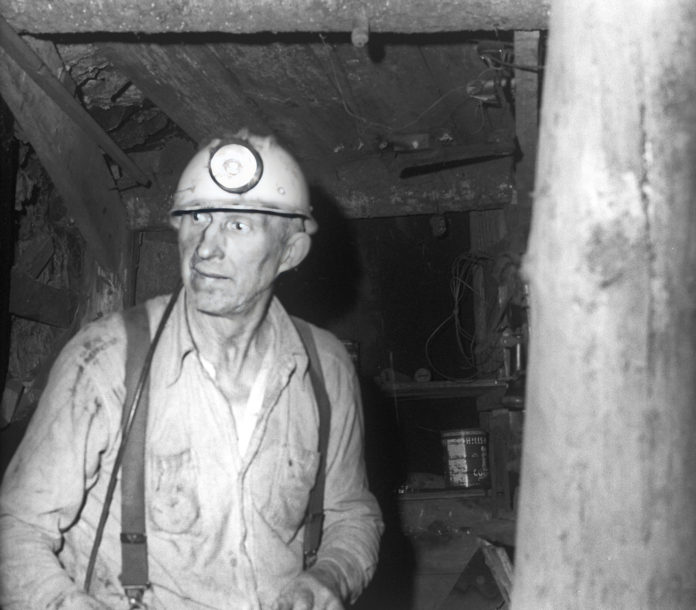Last week’s column detailed George Savicke’s 43 years of mining coal. He finished his career at Palmer Coking Coal Co.’s Rogers No. 3 mine in Ravensdale when this April 1974 photo was taken by Barry Kombol. Photo enhancements were undertaken by Doug ‘Boomer’ Burnham, a Tahoma High School photography teacher with a side photography business: www.BoomersPhotography.com
At the time Savicke was in the 3rd level doghole, a small opening along the gangway where mine implements such as saws and tools were kept. It’s also where the telephone was located, providing an important communication link between underground workers and the hoist operator on the surface. The term doghole is also applied to any underground coal mine that employed less than 15 men. In April 1974, there were only 12 miners working the day and night shifts at the Rogers No. 3 mine.
George Savicke was of Lithuania heritage. His father, Paul Charles Sawicke was born in Kursenai, Lithuania in 1874 to Anton and Barbara (Kukanowsa) when the area was under Russian control. Paul’s great-granddaughter, Melinda Carlino and great-great nephew, Mark Bolton reported he was a guard at one of the imperial palaces of Tsar Nicholas II. Paul and his wife, Anna was also from Kursenai, Lithuania, emigrating to Black Diamond in 1909. Together the couple bore four children who survived into adulthood, Mary (Keehner), Julie (Scouten), George, and Jan (Eltz). On Paul’s immigration paperwork the name Sawicke was shown with a W, but over time that misspelling was corrected to the more traditional Lithuanian Savicke with a V.
Like many ethnic immigrants to Black Diamond, Paul Sawicke went to work in the coal mines. He was tall, nearly six feet, yet slender with blue eyes and light brown hair. The Sawicke family must have worked hard and saved money as by November 1920, Paul signed a contract with Pacific Coast Coal Co. to purchase 3.1 acres of land on Lawson Street for $50 per acre. He also negotiated buying Company House #41 for $350, at a total purchase price for land and home of $512.42. The Sawicke family had lived in that same house since arriving in Black Diamond a decade earlier.
Within a year of Paul Sawicke signing his real estate contract, labor troubles reached Black Diamond. In response to falling coal prices at the end of World War I, coal companies across the nation sought wage reductions. The miners resisted those pay cuts, and in Washington state their union struck, followed by company lockouts.
On Aug. 31, 1921, Pacific Coast Coal joined other King County coal companies by evicting all union members from their homes on company-owned land, including those in Black Diamond. Tim Morgan, an 80-year-old and former coal miner who had long squabbled with the company came to the striker’s rescue. Morgan sold the union 16 acres where homes for striking miners were built. Tim also nailed the first plank on the first of 200 homes planned by the union. That area of west Black Diamond is still called Morganville.
Fortunately for the Sawickes, they owned their land and home, subject to payments required under their contract. Still by Dec. 1921, Paul Sawicke had fallen behind in payments and the company’s real estate manager, E.F. DeGrandpre threatened forfeiture. Paul Sawicke offered to apply proceeds from a proposed sale of 900 mine props he’d already cut to company specifications. The company turned him down with DeGrandpre responding, “Why should the company buy Sawicke’s props – is he buying the Company’s coal and merchandise?” In Jan. 1922 Paul Sawicke found the necessary $400 balance to complete the property purchase and avoid forfeiture.
Paul’s son, George, made his father proud. After graduating from high school in 1933, he soon found employment in the coal mines. George Savicke immediately joined the union, the United Mine Workers of America, and remained a member for over 60 years. In fact, he served as president of Local #6481 for 27 years. Sometime after his father’s 1950 death, George moved back to the family estate. While George died in 1995 and his wife, May in 2006, their Lawson Street home has remained with the Savicke family for over a century and is now occupied by their granddaughter, Melinda Carlino.







